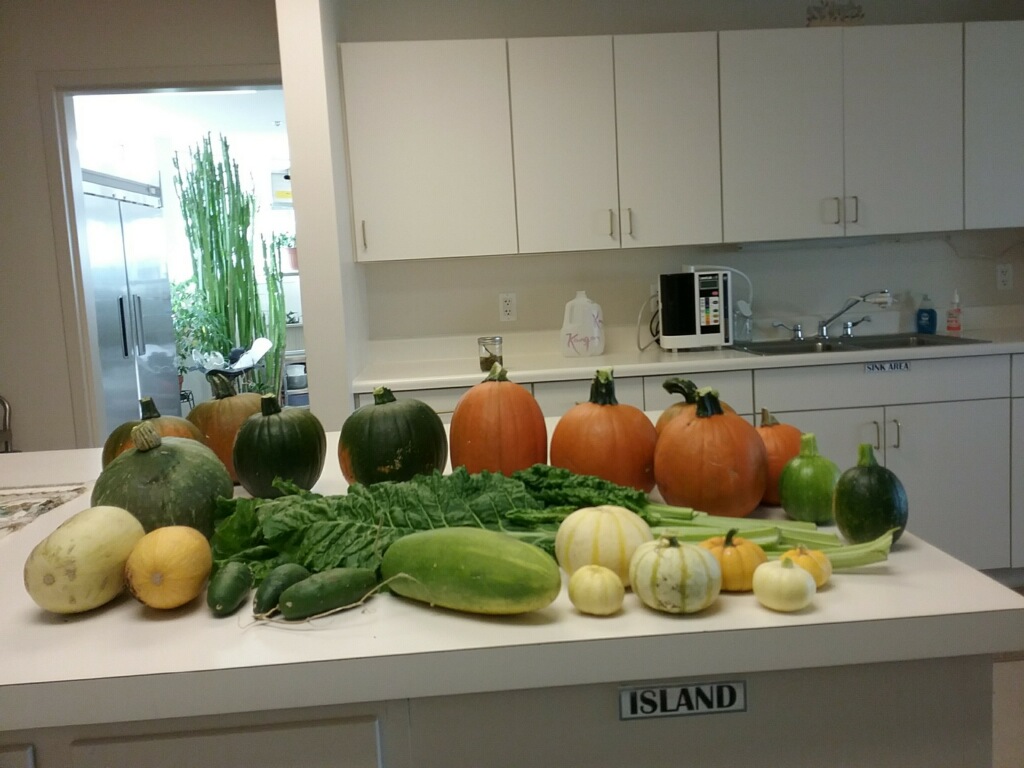By Lura Roti for SD Soil Health Coalition
Washing parsnips, peeling carrots, slicing zucchini and canning pickles, each day several sisters work together to assist in food preparation. And thanks to their garden plots, meal prep at Mother of God Monastery includes an abundance of homegrown fresh and preserved vegetables and fruits.
“We have a garden so we can eat healthy food that has not been processed and is grown in as healthy a way as possible,” explains Adrienne Kaufmann, one of the 35 Benedictine Sisters who call the Watertown monastery home.
So, when their garden’s production began to decrease a few years ago, the sisters were concerned and called on experts for advice. Turns out their garden’s soil was in poor health. “Evaluating the soil, we could see right away that overall the soil was unhealthy. Its soil structure was poor and there was a lack of biology – evidenced by the fact that there were no earthworms,” explains Baylee Lukonen, Soil Health Technician with South Dakota Soil Health Coalition. “Soil health is really the base of everything in life. Without soil health we are not able to have clean water or great nutritious foods.”
To restore the garden’s soil health, Lukonen suggested they implement no-till management practices.
“Soil restoration is really key. We thought we’d at least try it in a portion of our garden this growing season,” recalls Kaufmann. “Tilling our garden, it was explained to us, is like sending a tornado through the organisms that nourish the soil. Learning this was a turning point for me.”
As a way to jump start the soil health building process, Lukonen also suggested instead of planting a traditional garden, where each vegetable has its own designated area or row, the sisters plant a Milpa garden.
Also called chaos gardens because they do away with rows, Milpa gardens can feature as many as 40 different plant species and don’t require tillage. To plant, gardeners mix a variety of seeds together and drill or hand broadcast the seeds over a seedbed. They then water as they would a traditional garden.
“When the Milpa garden idea came up, I thought, ‘Hey, I could probably plant that,’” says 80-year-old Kaufmann, who hasn’t been gardening much in recent years due to three joint replacements. “I can’t crawl up and down the rows planting seed or pulling weeds like I used to.”
Based on an intercropping system originally designed by the Mayans, in Milpa gardens plants work together to crowd out weeds, share needed nutrients and build soil biomass.
“Everything feeds off each other. Roots communicate beneath the soil to exchange nutrients to meet their needs,” Lukonen says.
Companion plants grow well together because of natural synergies. For example, nitrogen-hungry plants, like corn and millet, provide sturdy stalks for legumes, like green beans and peas, to climb. While at the same time legumes fix nitrogen in the soil for the corn or millet to use. And flowers, like marigolds, encourage pollinator insects to visit the garden while at the same time repel unwanted garden pests.
“It’s the Milpa’s biodiversity that really increases the soil structure and microbiome,” says Lukonen, explaining microbiome is the term applied to fungi and bacteria which serve as the soil’s nutrient highway, transporting nutrients from one plant to another. “The more diverse the root system, the more diverse the fungi and bacteria, which allows for a greater exchange of nutrients.”
Earthworms signal soil is healing
Due to the excess moisture this growing season, the sisters had to wait until the end of June to plant their gardens. Kaufmann says the Milpa garden yielded some produce in spite of the strange growing season but exceeded her expectations in weed management. “What I loved most about the Milpa garden was its weed control. Because it took so long to get it planted, the weeds took off and were so thick that we had to hoe them out before we planted. When we got it planted, the millet was so pervasive that the weeds didn’t have a chance in the Milpa garden.”
Along with produce, Kaufmann says the millet also attracted more birds than they typically see. And when they put a spade into the soil beneath the Milpa garden, they discovered earthworms had taken up residence. A good sign, Lukonen says, that the soil’s health is improving. “Earthworms are a good sign that the biology is coming back. They are a good sign that other bacteria and fungi, which you can’t see with the naked eye, are also there.”
Seeing how their actions are helping to build the soil health of their garden, means a lot to Kaufmann, who credits her faith with her desire to care for the land. “My faith has everything to do with where my earth-centered values come from,” explains Kaufmann, who felt called by God to enter the community when she was 17. “I believe I am created to care for my family, my neighborhood, my community and I am also created to care for rivers, air and natural resources, like soil. If we don’t have topsoil, we cannot produce food. It’s as simple as that.”
To learn more about Milpa gardens, Milpa seed mixes, and soil health contact Cindy Zenk, S.D. Health Coalition Coordinator at sdsoilhealth@gmail.com or 605-280-4190.

0 Comments